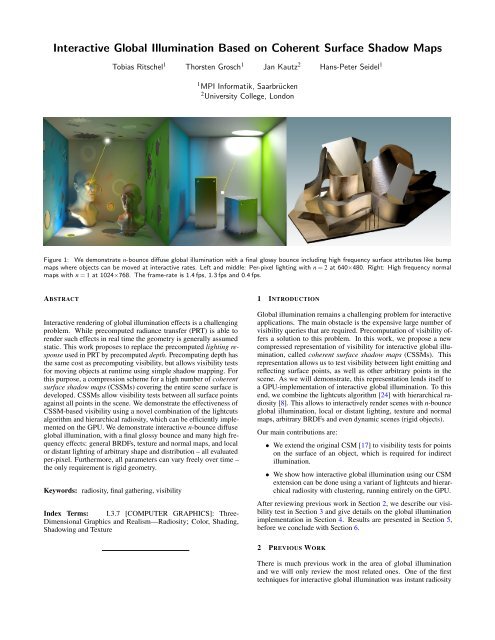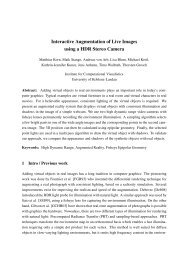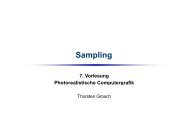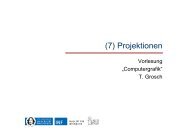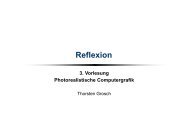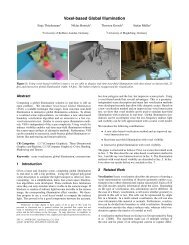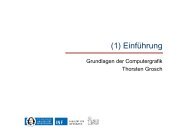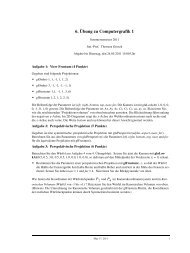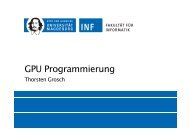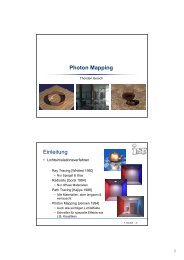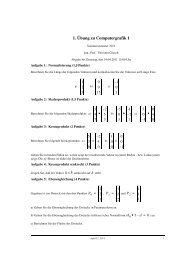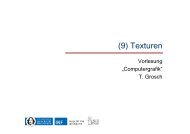Interactive Global Illumination Based on Coherent Surface Shadow ...
Interactive Global Illumination Based on Coherent Surface Shadow ...
Interactive Global Illumination Based on Coherent Surface Shadow ...
You also want an ePaper? Increase the reach of your titles
YUMPU automatically turns print PDFs into web optimized ePapers that Google loves.
<str<strong>on</strong>g>Interactive</str<strong>on</strong>g> <str<strong>on</strong>g>Global</str<strong>on</strong>g> <str<strong>on</strong>g>Illuminati<strong>on</strong></str<strong>on</strong>g> <str<strong>on</strong>g>Based</str<strong>on</strong>g> <strong>on</strong> <strong>Coherent</strong> <strong>Surface</strong> <strong>Shadow</strong> Maps<br />
Tobias Ritschel 1 Thorsten Grosch 1 Jan Kautz 2 Hans-Peter Seidel 1<br />
1 MPI Informatik, Saarbrücken<br />
2 University College, L<strong>on</strong>d<strong>on</strong><br />
Figure 1: We dem<strong>on</strong>strate n-bounce diffuse global illuminati<strong>on</strong> with a final glossy bounce including high frequency surface attributes like bump<br />
maps where objects can be moved at interactive rates. Left and middle: Per-pixel lighting with n = 2 at 640×480. Right: High frequency normal<br />
maps with n = 1 at 1024×768. The frame-rate is 1.4 fps, 1.3 fps and 0.4 fps.<br />
ABSTRACT<br />
<str<strong>on</strong>g>Interactive</str<strong>on</strong>g> rendering of global illuminati<strong>on</strong> effects is a challenging<br />
problem. While precomputed radiance transfer (PRT) is able to<br />
render such effects in real time the geometry is generally assumed<br />
static. This work proposes to replace the precomputed lighting resp<strong>on</strong>se<br />
used in PRT by precomputed depth. Precomputing depth has<br />
the same cost as precomputing visibility, but allows visibility tests<br />
for moving objects at runtime using simple shadow mapping. For<br />
this purpose, a compressi<strong>on</strong> scheme for a high number of coherent<br />
surface shadow maps (CSSMs) covering the entire scene surface is<br />
developed. CSSMs allow visibility tests between all surface points<br />
against all points in the scene. We dem<strong>on</strong>strate the effectiveness of<br />
CSSM-based visibility using a novel combinati<strong>on</strong> of the lightcuts<br />
algorithm and hierarchical radiosity, which can be efficiently implemented<br />
<strong>on</strong> the GPU. We dem<strong>on</strong>strate interactive n-bounce diffuse<br />
global illuminati<strong>on</strong>, with a final glossy bounce and many high frequency<br />
effects: general BRDFs, texture and normal maps, and local<br />
or distant lighting of arbitrary shape and distributi<strong>on</strong> – all evaluated<br />
per-pixel. Furthermore, all parameters can vary freely over time –<br />
the <strong>on</strong>ly requirement is rigid geometry.<br />
Keywords: radiosity, final gathering, visibility<br />
Index Terms: I.3.7 [COMPUTER GRAPHICS]: Three-<br />
Dimensi<strong>on</strong>al Graphics and Realism—Radiosity; Color, Shading,<br />
<strong>Shadow</strong>ing and Texture<br />
1 INTRODUCTION<br />
<str<strong>on</strong>g>Global</str<strong>on</strong>g> illuminati<strong>on</strong> remains a challenging problem for interactive<br />
applicati<strong>on</strong>s. The main obstacle is the expensive large number of<br />
visibility queries that are required. Precomputati<strong>on</strong> of visibility offers<br />
a soluti<strong>on</strong> to this problem. In this work, we propose a new<br />
compressed representati<strong>on</strong> of visibility for interactive global illuminati<strong>on</strong>,<br />
called coherent surface shadow maps (CSSMs). This<br />
representati<strong>on</strong> allows us to test visibility between light emitting and<br />
reflecting surface points, as well as other arbitrary points in the<br />
scene. As we will dem<strong>on</strong>strate, this representati<strong>on</strong> lends itself to<br />
a GPU-implementati<strong>on</strong> of interactive global illuminati<strong>on</strong>. To this<br />
end, we combine the lightcuts algorithm [24] with hierarchical radiosity<br />
[8]. This allows to interactively render scenes with n-bounce<br />
global illuminati<strong>on</strong>, local or distant lighting, texture and normal<br />
maps, arbitrary BRDFs and even dynamic scenes (rigid objects).<br />
Our main c<strong>on</strong>tributi<strong>on</strong>s are:<br />
• We extend the original CSM [17] to visibility tests for points<br />
<strong>on</strong> the surface of an object, which is required for indirect<br />
illuminati<strong>on</strong>.<br />
• We show how interactive global illuminati<strong>on</strong> using our CSM<br />
extensi<strong>on</strong> can be d<strong>on</strong>e using a variant of lightcuts and hierarchical<br />
radiosity with clustering, running entirely <strong>on</strong> the GPU.<br />
After reviewing previous work in Secti<strong>on</strong> 2, we describe our visibility<br />
test in Secti<strong>on</strong> 3 and give details <strong>on</strong> the global illuminati<strong>on</strong><br />
implementati<strong>on</strong> in Secti<strong>on</strong> 4. Results are presented in Secti<strong>on</strong> 5,<br />
before we c<strong>on</strong>clude with Secti<strong>on</strong> 6.<br />
2 PREVIOUS WORK<br />
There is much previous work in the area of global illuminati<strong>on</strong><br />
and we will <strong>on</strong>ly review the most related <strong>on</strong>es. One of the first<br />
techniques for interactive global illuminati<strong>on</strong> was instant radiosity
[11], where many virtual point lights (VPLs) are placed <strong>on</strong> surfaces<br />
where indirect light is to be emitted. Rendering can then be d<strong>on</strong>e <strong>on</strong><br />
GPUs, achieving near-interactive rates. The lightcuts algorithm [24]<br />
as well as matrix row-column sampling [9] allow illuminati<strong>on</strong> from<br />
the required large number (several thousands) of VPLs in sublinear<br />
time. The visibility test from VPLs towards the scene is an important<br />
building block for such algorithms and two methods are available:<br />
raytracing and shadow mapping. Raytracing for many VPLs [22]<br />
has seen much improvement in speed over recent years <strong>on</strong> CPUs,<br />
but its efficiency is still lacking <strong>on</strong> current GPUs. While shadow<br />
mapping is desirable for current GPUs, it is restricted by memory<br />
requirements and the fact that computati<strong>on</strong> of shadow map pixels<br />
that are not used to query a VPL later <strong>on</strong> is wasteful. To remedy<br />
this, Laine et al. [13] find important VPLs (and their shadow maps)<br />
and re-use them over time in order to compute <strong>on</strong>e-bounce indirect<br />
illuminati<strong>on</strong> from a single point light. Pre-computed and compressed<br />
depth maps [17] allow visibility tests between moving objects and a<br />
high number of lights outside their c<strong>on</strong>vex hulls using simple shadow<br />
mapping, but is unsuitable for VPLs placed <strong>on</strong> an object’s surface.<br />
Recently, several full global illuminati<strong>on</strong> algorithms tailored to<br />
GPUs were proposed. Dachsbacher et al. [6] and D<strong>on</strong>g et al. [7]<br />
dem<strong>on</strong>strate global illuminati<strong>on</strong> using techniques based <strong>on</strong> hierarchical<br />
radiosity, yet avoiding traditi<strong>on</strong>al visibility computati<strong>on</strong>. Only<br />
per-vertex and low-frequency lighting is supported due to directi<strong>on</strong>al<br />
discretizati<strong>on</strong>. Dachsbacher and Stamminger [5] introduce the idea<br />
of reflective shadow maps, where shadow map texels corresp<strong>on</strong>d<br />
to VPLs. However, no hierarchical lighting and no visibility were<br />
taken into account.<br />
The classic PRT [19] approach allows static scenes under distant<br />
low-frequency lighting, visibility and BRDFs, which was extended<br />
to all frequencies in [14] and other follow up work. In PRT, scenes<br />
are usually assumed to remain static. Limited dynamic scenes (rigid<br />
objects) can be supported, e.g. by Zhou et al. [27], but indirect<br />
illuminati<strong>on</strong> is then very difficult to achieve [10][15]. This was<br />
generalized to deforming geometry in [16]. Recently, Akerlund et<br />
al. [1] dem<strong>on</strong>strated real-time <strong>on</strong>e-bounce global illuminati<strong>on</strong> in<br />
c<strong>on</strong>juncti<strong>on</strong> with local lighting. However, geometry still needs to be<br />
static due the use of precomputed visibility.<br />
In this work, we present n-bounce global illuminati<strong>on</strong> for dynamic<br />
scenes c<strong>on</strong>sisting of several rigid objects.<br />
3 COHERENT SURFACE SHADOW MAPS<br />
3.1 CSM and Limitati<strong>on</strong>s<br />
<strong>Coherent</strong> <strong>Shadow</strong> Maps (CSM) are a generalizati<strong>on</strong> of shadow maps.<br />
Traditi<strong>on</strong>al shadow mapping allows visibility queries from a single<br />
light positi<strong>on</strong> to all scene points. CSMs generalize this to visibility<br />
queries between nearly all possible light positi<strong>on</strong>s – namely those<br />
outside the c<strong>on</strong>vex hull of the scene – and all possible scene points.<br />
At the cost of precomputati<strong>on</strong> and quantizati<strong>on</strong>, this allows visibility<br />
tests similar to raytracing, but without shooting any rays.<br />
To this end, a large number of orthographic depth maps, viewing<br />
the object from a large number of directi<strong>on</strong>s are precomputed and<br />
compressed. Compressi<strong>on</strong> proceeds by first determining a coherent<br />
sequence of depth maps. The sequence of depth values al<strong>on</strong>g each<br />
spatial pixel is then compressed by approximating it with a piecewise<br />
c<strong>on</strong>stant approximati<strong>on</strong>, which can be shown to be a lossless<br />
compressi<strong>on</strong> [25]. This piecewise c<strong>on</strong>stant approximati<strong>on</strong> is then<br />
well-suited for compressi<strong>on</strong>. Rendering with CSMs is similar to<br />
traditi<strong>on</strong>al shadow mapping [26]. For a given scene point p <strong>on</strong> the<br />
object, the depth map D which corresp<strong>on</strong>ds to the incoming light<br />
directi<strong>on</strong> is selected. The compressed depth value stored in D is<br />
decompressed and compared to the depth of p seen from D. For<br />
details we refer to Ritschel et al. [17].<br />
As noted, CSMs <strong>on</strong>ly allow for visibility queries with light positi<strong>on</strong>s<br />
outside the c<strong>on</strong>vex hull of the object. One example is shown in Fig. 2:<br />
An orthographic depth map is viewing the object from outside and a<br />
single depth value z xy is stored for this viewing directi<strong>on</strong>. However,<br />
further depth values al<strong>on</strong>g that ray would be required to test if the<br />
points p i and p j are mutually visible or not. <strong>Coherent</strong> surface shadow<br />
maps solve this issue, as will be shown in the next subsecti<strong>on</strong>.<br />
q<br />
Figure 2: Limitati<strong>on</strong>s of the CSM data structure: A visibility query<br />
between the points p i and p j is not possible because <strong>on</strong>ly <strong>on</strong>e depth<br />
value z xy is stored for this directi<strong>on</strong> in pixel q. In this example, the<br />
required depth values between p i and p j are omitted.<br />
z <br />
3.2 <strong>Coherent</strong> <strong>Surface</strong> <strong>Shadow</strong> Maps<br />
To allow lights inside the c<strong>on</strong>vex hull, we propose <strong>Coherent</strong> <strong>Surface</strong><br />
<strong>Shadow</strong> Maps (CSSM). Here, a depth cube map is swept al<strong>on</strong>g<br />
the surface of the object and the depth values in all directi<strong>on</strong>s are<br />
recorded. One example is shown in Fig. 3. In case of a coherent<br />
sequence of depth cube maps, the same compressi<strong>on</strong> scheme used<br />
for CSMs can be applied: An arbitrary depth value between the first<br />
and sec<strong>on</strong>d intersecti<strong>on</strong> point is stored for each pixel [25].<br />
Different from the original CSMs, we now use depth from an inside<br />
out perspective. This has the benefit of permitting visibility tests for<br />
all points in any locati<strong>on</strong>. The challenge is to find a way to place the<br />
depth cube maps in such a way that:<br />
• The mesh surface has a good coverage – this allows high<br />
frequency visibility;<br />
• The coherence between depth maps is high – resulting in lower<br />
memory usage and shorter decompressi<strong>on</strong> time<br />
Figure 3: The CSSM stores depth values recorded from various<br />
points <strong>on</strong> the surface of the object. Therefore, a depth cube map is<br />
swept al<strong>on</strong>g the surface of the object. A few of these cube maps are<br />
visualized <strong>on</strong> the back of the bunny.<br />
3.2.1 Depth Cube Map Details<br />
One half of the depth pixels of a depth cube map are in the negative<br />
half-space and therefore c<strong>on</strong>tain useless depth values from inside<br />
the object. This causes <strong>on</strong>ly a small amount of additi<strong>on</strong>al memory<br />
because the depth value of these pixels is set to ’d<strong>on</strong>’t care’ which<br />
means that an arbitrary value can be stored here after compressi<strong>on</strong>.<br />
p <br />
p
Alternatively, a hemi-cube could be used and rotated to the tangent<br />
frame at each surface positi<strong>on</strong>. We did not c<strong>on</strong>sider this opti<strong>on</strong><br />
because of the lower coherence of depth values for a pixel due to the<br />
rotati<strong>on</strong> of the depth cube map. To avoid depth fighting problems,<br />
we use linear depth values [2]. In this way, we can use a small value<br />
for the near plane without precisi<strong>on</strong> problems for larger depth values.<br />
Some small surface details in fr<strong>on</strong>t of the near plane can be lost, here<br />
normal mapping is used to simulate them. The far plane is adjusted<br />
to the maximum diameter of the scene.<br />
3.2.2 Visibility Query<br />
A visibility query works as follows (see Fig. 4): To test if the<br />
point p i (3D positi<strong>on</strong> of the current fragment) is in shadow of an<br />
arbitrary sender point p j , the depth values at p j are determined. After<br />
projecting p i in the coordinate system of p j , the pixel positi<strong>on</strong> q and<br />
the depth value z xy are known. There is an occlusi<strong>on</strong> between p i and<br />
p j if z xy is smaller than q z (the depth value of p i in the coordinate<br />
system of p j ). Because of the discretizati<strong>on</strong> (depth map resoluti<strong>on</strong><br />
and cube map positi<strong>on</strong>s), banding artifacts can appear in shadow<br />
regi<strong>on</strong>s. The same generalized percentage closer filtering (PCF)<br />
used with CSMs can be used to improve shadow quality.<br />
p <br />
z <br />
q<br />
p <br />
Figure 5: Illuminated atlas for the Cornell Box scene.<br />
positi<strong>on</strong>. See left of Figure 6 and Figure 7 for a visualizati<strong>on</strong> of this<br />
process.<br />
The Spiral strategy moves al<strong>on</strong>g the border of each chart, marking<br />
each visited texel. This can be thought of as walking al<strong>on</strong>g left hand<br />
side of the border as l<strong>on</strong>g as possible. If there is no free texel in<br />
the neighborhood, we step back recursively until a free neighbor<br />
is available. Typically, this leads to a spiral-shape where texels are<br />
visited from outside to inside. As before, a depth cube map is created<br />
for the positi<strong>on</strong> associated with each texel. The right side of Figure 6<br />
and Figure 7 show this traversal strategy.<br />
1<br />
1<br />
3 3<br />
Figure 4: CSSM visibility test: To test visibility from the point p j to<br />
p i , we project p i into the cube map of p j giving pixel q and compare<br />
it’s depth z xy to the depth of p i .<br />
2<br />
2<br />
3.2.3 <strong>Coherent</strong> Depth Cube Maps through Atlas Traversal<br />
Our goal is to find a sequence of depth cube maps with a minimal<br />
amount of storage after compressi<strong>on</strong>. Similar to the CSM, coherence<br />
between the depth maps is an important prec<strong>on</strong>diti<strong>on</strong> for a<br />
good compressi<strong>on</strong>. Finding a coherent sequence can therefore be<br />
visualized as moving a depth cube map al<strong>on</strong>g the surface of an object<br />
in small steps such that <strong>on</strong>ly small changes in the depth values occur,<br />
thereby visiting each locati<strong>on</strong> of the surface exactly <strong>on</strong>ce. Such a<br />
parametrizati<strong>on</strong> of the surface of an arbitrary complex object is not<br />
a trivial task. A comm<strong>on</strong> way to parameterize the surface of an<br />
object is to use a texture atlas, which can either be created manually<br />
or automatically (we use Autodesk 3ds Max). The atlas is a large<br />
texture which c<strong>on</strong>tains the following informati<strong>on</strong> for each texel: 3D<br />
positi<strong>on</strong>, normal, area, radiance and BRDF parameters (eg. diffuse<br />
color, roughness, glossiness).<br />
An atlas c<strong>on</strong>sists of so-called charts describing c<strong>on</strong>nected regi<strong>on</strong>s<br />
of the object (see Fig. 5 for an example). Moving from <strong>on</strong>e texel to<br />
its neighbour is likely to be coherent if we stay inside a chart. We<br />
therefore avoid to simply visit all texels inside the atlas, and instead<br />
develop two strategies for a coherent traversal where <strong>on</strong>e chart after<br />
the other is visited: Zig-Zag and Spiral.<br />
For the Zig-Zag strategy we first determine the bounding box of the<br />
(first) chart. We then visit all texels inside the box in a zig-zag pattern<br />
from top to bottom. For each texel, we retrieve the corresp<strong>on</strong>ding 3D<br />
positi<strong>on</strong> and generate a depth cube map for it. If a texel is undefined<br />
(or bel<strong>on</strong>gs to a different chart), we skip it. After visiting all texels<br />
of <strong>on</strong>e chart, we move to the next chart which has the closest 3D<br />
Figure 6: <strong>Coherent</strong> traversal in an atlas with three charts: A traversal<br />
strategy is used for each chart. Left: Zig-Zag. Right: Spiral.<br />
Figure 7: Traversing the Cornell box (left: zig-zag, right: spiral)<br />
and the Cornell Church with a depth cube map in a coherent order.<br />
Resoluti<strong>on</strong> is artificially low to make the path more visible.<br />
We do not use the Hilbert pattern (used for CSM traversal) because it<br />
is not suited for arbitrary shaped charts. If there is no parametrizati<strong>on</strong><br />
available, we resort to a traversal that greedily walks a number of<br />
random samples that were distributed evenly across the surface.<br />
3.3 Moving Objects<br />
In the case of moving objects, each object c<strong>on</strong>tains its own CSSM<br />
and an additi<strong>on</strong>al CSM. After a rigid transformati<strong>on</strong>, the same visibility<br />
test as described in Sec. 3.2.2 can still be performed for two<br />
points <strong>on</strong> the same object. To test if there is an occluder between
two points p i and p j located <strong>on</strong> different objects, each object uses its<br />
own CSSM to check for self-occlusi<strong>on</strong>s first. There is an occlusi<strong>on</strong><br />
between the two points p i and p j if <strong>on</strong>e of the two depth tests reports<br />
a self-occlusi<strong>on</strong>. In case of no self-occlusi<strong>on</strong>, all other objects must<br />
be tested as possible occluders between p i and p j . This kind of<br />
visibility test cannot be performed with the CSSM. Here the CSM is<br />
required, because the visibility of an arbitrary ray can be computed<br />
(without knowing any point <strong>on</strong> the object). So the CSM of each<br />
additi<strong>on</strong>al object is used to test if the ray, starting from p i in directi<strong>on</strong><br />
towards p j is blocked by this object. Recall that the CSM cannot<br />
compute visibility between two points inside an object, so both data<br />
structures are required.<br />
Visibility tests with moving objects are possible as l<strong>on</strong>g as the c<strong>on</strong>vex<br />
hulls of the individual objects do not overlap. Otherwise, the depth<br />
informati<strong>on</strong> stored in the CSSM can become invalid because objects<br />
might be placed at a smaller distance than the depth values stored in<br />
the CSSM.<br />
To enable a GPU implementati<strong>on</strong> we allow <strong>on</strong>ly a refinement of the<br />
sender, the receiver is always a leaf. The Refine functi<strong>on</strong> is therefore<br />
a loop over all leaves in the tree and the appropriate sender levels<br />
are computed for each leaf (this corresp<strong>on</strong>ds to a cut through the<br />
tree). Because of this limitati<strong>on</strong>, the PushPull functi<strong>on</strong> simplifies to<br />
a Pull functi<strong>on</strong> to compute the radiosity values of the internal nodes.<br />
Fig. 8 shows a simple example of our GPU HRC algorithm.<br />
Repeat<br />
Compute Cut Gather Pull<br />
4 GLOBAL ILLUMINATION<br />
The original CSM data structure allows visibility tests for arbitrary<br />
direct illuminati<strong>on</strong> (point lights, area lights or envir<strong>on</strong>ment maps)<br />
but any emitter has to be outside the c<strong>on</strong>vex hull of the object<br />
(Fig. 2), making the original CSMs unsuitable for computing indirect<br />
illuminati<strong>on</strong>. In c<strong>on</strong>trast, the new CSSM allows visibility tests<br />
between arbitrary points within an object, as described in Sec. 3.2.2.<br />
This enables the computati<strong>on</strong> of additi<strong>on</strong>al indirect bounces of light<br />
with correct occlusi<strong>on</strong>. In this secti<strong>on</strong>, we describe how advanced<br />
lighting can be computed using CSSMs, including direct lighting,<br />
an arbitrary number of diffuse indirect bounces and a final glossy<br />
bounce towards the viewer.<br />
Our basic idea is to compute indirect bounces by illuminating the<br />
atlas [3]. Here, geometric informati<strong>on</strong> and material data are available<br />
for each texel and therefore each texel in the atlas represents a small<br />
patch. A simple soluti<strong>on</strong> would be to use each texel as a sender, like<br />
in GPU progressive refinement radiosity [4]. Since this is too slow<br />
for complex scenes, we used a clustering approach.<br />
Our lighting simulati<strong>on</strong> c<strong>on</strong>sists of two steps:<br />
• A GPU versi<strong>on</strong> of hierarchical radiosity with clustering (HRC)<br />
to compute an arbitrary number of diffuse bounces. Here,<br />
texels in the atlas are illuminated.<br />
• A GPU versi<strong>on</strong> of final gathering including glossy materials<br />
based <strong>on</strong> lightcuts. Here, pixels in the framebuffer are illuminated.<br />
Figure 8: One iterati<strong>on</strong> of GPU HRC for a simple scene. The leaf<br />
nodes in the tree corresp<strong>on</strong>d to texels in the atlas. We assume that all<br />
nodes already c<strong>on</strong>tain the direct light. For refinement, the appropriate<br />
sender levels are selected for each receiver leaf - this results in a cut<br />
through the hierarchy (left). Now, the receiver leaf node gathers<br />
from all nodes of the cut (middle). For simplificati<strong>on</strong>, the example<br />
shows the cut and the gather links for <strong>on</strong>ly <strong>on</strong>e leaf. After gathering,<br />
some red and green color bleeding is visible in the leaves. Finally, a<br />
c<strong>on</strong>sistent hierarchy is restored with a pull operati<strong>on</strong> (right).<br />
4.2 Hierarchy<br />
Given an atlas with a 3D positi<strong>on</strong> for each texel, an implicit hierarchy<br />
is given by building a MIP map which stores at each texel the extent<br />
of the spatial locati<strong>on</strong>s of all child-texels in the finer mip map levels.<br />
However, we observed that this does not lead to a good hierarchy<br />
because texels from different charts, located at completely different<br />
spatial positi<strong>on</strong>s, will be combined at a certain level. Instead, we<br />
build a separate binary tree based <strong>on</strong> a standard median cut algorithm.<br />
To allow a fast computati<strong>on</strong> of upper bounds for light transmissi<strong>on</strong><br />
during refinement, a hierarchy of bounding spheres over the original<br />
3D points is created as well (see Fig. 9). This hierarchy is computed<br />
as a pre-process, as neither the atlas nor the texels’ spatial locati<strong>on</strong>s<br />
change at run-time, since we assume rigid objects.<br />
4.1 Hierarchical Radiosity<br />
The original algorithm for hierarchical radiosity [8] with clustering<br />
[21][18] c<strong>on</strong>sists of three steps, repeated until c<strong>on</strong>vergence: Refine,<br />
Gather and PushPull. The Refine step recursively subdivides the<br />
self-link of the root node depending <strong>on</strong> an oracle functi<strong>on</strong>. The<br />
Gather step then computes the received radiosity for each node<br />
by summing the c<strong>on</strong>tributi<strong>on</strong> of all links arriving at the node. In<br />
the PushPull step, a c<strong>on</strong>sistent hierarchy is established by adding<br />
the radiosities from top to bottom and computing area-weighted<br />
averages bottom-up.<br />
4.1.1 Hierarchical Radiosity <strong>on</strong> the GPU<br />
A direct implementati<strong>on</strong> of hierarchical radiosity <strong>on</strong> a GPU is difficult,<br />
especially because of the Refine functi<strong>on</strong>, which establishes<br />
links between arbitrary levels of senders and receivers, thereby recursively<br />
traversing both source and receiver tree simultaneously.<br />
Figure 9: The bottom levels of the bounding sphere hierarchy.<br />
4.2.1 Hierarchy <strong>on</strong> the GPU<br />
This binary tree is stored as a linear array for fast, stack-less traversal.<br />
For each node N, we store two pointers: a child- and a skip-pointer<br />
[20]. The child-pointer points to the left child. The skip-pointer<br />
points to the next node for depth-first traversal, if the subtree below<br />
N should be skipped. These two pointers are sufficient for a depthfirst<br />
traversal: Starting from the root, always use the child-pointer
until a leaf is reached; then use the skip-pointer and c<strong>on</strong>tinue. Moreover,<br />
this enables a selective traversal (required for refinement), as<br />
described in the next subsecti<strong>on</strong>.<br />
For each node, all data is stored in 128 bits using a single 32-bit<br />
RGBA integer texel. 24 bits are used for: Center positi<strong>on</strong>, average<br />
normal and radiant intensity, 8 bits for: radius, normal c<strong>on</strong>e angle<br />
and area, and 16 bits for both pointers. Due to the size limitati<strong>on</strong>s of<br />
<strong>on</strong>e-dimensi<strong>on</strong>al textures, the hierarchy is stored in a native layout<br />
as a two-dimensi<strong>on</strong>al texture. Both pointers are c<strong>on</strong>verted into this<br />
layout when storing the hierarchy. One example is shown in the left<br />
of Fig. 11.<br />
4.3 Hierarchy Traversal<br />
The data structure introduced in the previous secti<strong>on</strong> enables a combined<br />
implementati<strong>on</strong> of Refine and Gather for a receiver leaf node<br />
N r : Starting from the root, the tree is traversed in depth-first order<br />
by following the child-pointer as l<strong>on</strong>g as an oracle functi<strong>on</strong> decides<br />
to refine the current sender node N s . In case of no refinement, N s<br />
is an appropriate sender level and the radiance transmissi<strong>on</strong> from<br />
N s to N r is computed and accumulated. To accomplish this, a form<br />
factor and a CSSM-based visibility value are computed here. Now,<br />
all nodes below N s can be ignored by following the skip-pointer,<br />
and the process can be repeated. The pseudo-code for this traversal<br />
is shown in Fig. 10.<br />
We use an energy-based refinement oracle which computes an upper<br />
bound of the received radiance L max from N s to N r . The same upper<br />
bound computati<strong>on</strong> as presented in [24] is used here. Now, N s is<br />
refined if the t<strong>on</strong>e-mapped value of L max is above a user-defined<br />
threshold. In this way, the refinement adapts to the current display<br />
settings (we use a simple gamma t<strong>on</strong>e mapper in our examples).<br />
senderNode = root<br />
L = 0<br />
while(senderNode != NULL) {<br />
if oracle(senderNode, receiverNode, threshold) {<br />
senderNode = senderNode.leftChild // Refine<br />
}<br />
else {<br />
L += computeRadiance(senderNode, receiverNode)<br />
senderNode = senderNode.skip // Gather<br />
}<br />
}<br />
Figure 10: Pseudocode for stack-less GPU tree traversal. This<br />
combines the Refine and Gather step for an arbitrary receiver leaf<br />
node. No links need to be stored in this way.<br />
4.4 Final Gathering<br />
The direct visualizati<strong>on</strong> of a radiosity soluti<strong>on</strong> suffers from discretizati<strong>on</strong><br />
artifacts, like jagged shadows. Better, but slower results<br />
are obtained when using final gathering for display. Recently, Walter<br />
et al. [24] introduced lightcuts, a fast final gathering method. Their<br />
original algorithm assumes a c<strong>on</strong>verged lighting simulati<strong>on</strong> from<br />
which a hierarchy of VPLs is created. To select the minimal number<br />
of VPLs for a given receiver point, an initial cut through the hierarchy<br />
is computed (usually just the root node). Then the node inside<br />
the cut with the largest error relative to the total incident radiance<br />
is selected. If this relative error is perceivable for the human eye<br />
(this means larger than two percent due to Weber’s law) the node is<br />
removed and its children are placed into the cut. This is repeated<br />
until the node with the largest c<strong>on</strong>tributi<strong>on</strong> is below two percent or a<br />
maximum number of nodes is reached.<br />
Figure 11: The glossy Cornell Box and the corresp<strong>on</strong>ding VPL tree<br />
which stores direct light in a texture (left). The indirect light is<br />
computed by final gathering. The cut size (number of nodes in the<br />
cut) for gathering indirect light is visualized <strong>on</strong> the right.<br />
4.4.1 Final Gathering <strong>on</strong> the GPU<br />
We found the original lightcuts algorithm unsuitable for a GPU<br />
implementati<strong>on</strong> for two reas<strong>on</strong>s. First, it requires a priority queue to<br />
quickly identify the node with the largest error, which is difficult to<br />
maintain efficiently <strong>on</strong> a GPU. Sec<strong>on</strong>dly, the original error bound is<br />
quite expensive to compute.<br />
Instead, we propose to c<strong>on</strong>struct a simplified cut for an arbitrary<br />
receiver point: After computing multiple diffuse bounces, all nodes<br />
in the hierarchy are VPLs which c<strong>on</strong>tain direct and indirect light.<br />
Therefore, the same algorithm as shown in Fig. 10 can be used to<br />
compute the cut and gather from all nodes in the cut. The <strong>on</strong>ly<br />
difference is, that the receiver node has to be replaced by the receiver<br />
positi<strong>on</strong> of the current framebuffer pixel. Because the final bounce<br />
allows glossy surfaces, the oracle functi<strong>on</strong> now includes the computati<strong>on</strong><br />
of an upper bound of the Ph<strong>on</strong>g BRDF [24] for computing<br />
L max . This approach poses no c<strong>on</strong>straints <strong>on</strong> the final receiver pixel<br />
at all. We are free to use normal maps, high frequency textures and<br />
arbitrary BRDFs. Fig. 11 (right) shows a visualizati<strong>on</strong> of the cut<br />
size we achieve: For large regi<strong>on</strong>s in the image, a low number of<br />
VPLs is sufficient for a good quality. A direct visualizati<strong>on</strong> of the<br />
illuminated atlas is possible, but better visual results are obtained<br />
with final gathering, as shown in Fig 17.<br />
In comparis<strong>on</strong> with the original lightcuts alorithm, we use an energybased<br />
oracle instead of a perceptually-based criteri<strong>on</strong>. N<strong>on</strong>etheless,<br />
we found that for a GPU implementati<strong>on</strong>, the benefits of the simplificati<strong>on</strong>s<br />
outweigh the algorithmic deficiencies. Recently, Akerlund<br />
et al. also used cuts [1] for global illuminati<strong>on</strong>. However, they precompute<br />
the entire cut for static vertices, whereas we find the cuts<br />
dynamically for each pixel.<br />
4.5 Jittering<br />
One problem of VPL-based global illuminati<strong>on</strong> is the limitati<strong>on</strong> to<br />
moderately glossy BRDFs. When glossiness is increased, single<br />
highlights become apparent where a c<strong>on</strong>tinuous highlight should<br />
appear. We mitigate these artifacts in our approach by associating<br />
an approximate area with every VPL from which we pick a random<br />
locati<strong>on</strong> instead of the VPL’s center locati<strong>on</strong>. When several frames<br />
with different random locati<strong>on</strong> samples are averaged this ’VPL bias’<br />
can be removed as can be seen in Fig. 12.
in our examples, the direct lighting is computed from spotlights with<br />
shadow maps.<br />
Figure 12: A highly glossy Cornell Box without jittering showing<br />
VPL bias (left). The jittered image (middle) takes 20 s to c<strong>on</strong>verge.<br />
The right image shows the absolute difference.<br />
4.6 Discretizati<strong>on</strong> Artifacts<br />
Like in all sampling-based approaches, aliasing is a central problem.<br />
Our visibility computati<strong>on</strong> has two possible sources of aliasing: The<br />
spatial discretizati<strong>on</strong> due to the atlas and the limited resoluti<strong>on</strong> of the<br />
depth cube maps. Fig. 13 dem<strong>on</strong>strates the visual effect of different<br />
resoluti<strong>on</strong>s of the atlas. Fig. 14 shows the difference if the CSSM<br />
visibility test is replaced by an exact ray query to the VPL. Note<br />
that the error introduced due to the depth cube map discretizati<strong>on</strong><br />
(6 × 64 × 64) is hard to perceive, the banding artifacts appear due to<br />
the discretizati<strong>on</strong> of the atlas (64 × 64).<br />
Indirect Light M<strong>on</strong>te Carlo rendering with importance sampling<br />
[17] can also be used for the computati<strong>on</strong> of indirect bounces instead<br />
of using HRC. Here, the atlas with the direct light serves as a<br />
probability density functi<strong>on</strong> where samples are taken with a probability<br />
proporti<strong>on</strong>al to the atlas texel radiance. In combinati<strong>on</strong> with<br />
progressive rendering, this leads to a soluti<strong>on</strong> that runs at interactive<br />
rates and c<strong>on</strong>verges to the correct soluti<strong>on</strong> if the camera is not moving.<br />
However, importance sampling solely based <strong>on</strong> radiance does<br />
not take distance or occlusi<strong>on</strong> into account. C<strong>on</strong>sequently, many<br />
samples are taken from distant or invisible regi<strong>on</strong>s, resulting in a<br />
very slow c<strong>on</strong>vergence. Therefore, we prefer hierarchical radiosity<br />
for indirect lighting.<br />
Instant Radiosity Using an atlas to compute indirect light transport<br />
can be seen as covering the entire surface with small lambertian<br />
area lights. This is different to reflective shadow maps [5], where<br />
individual pixels in a projective texture from the light’s point of view<br />
are used. <str<strong>on</strong>g>Illuminati<strong>on</strong></str<strong>on</strong>g> atlases enables the use of general direct lighting,<br />
which may not come from a single point light, and also allows<br />
for more than <strong>on</strong>e-bounce indirect illuminati<strong>on</strong>. Just like in classic<br />
radiosity [8], the illuminati<strong>on</strong> atlas corresp<strong>on</strong>ds to a discretizati<strong>on</strong> of<br />
the scene surfaces but without the overhead of meshing and is thus<br />
more amenable to a GPU implementati<strong>on</strong>. Our method can also be<br />
interpreted in terms of instant radiosity [11]: We fix a large number<br />
of VPLs <strong>on</strong> the surface beforehand, so we can precompute CSSMs<br />
and enable fast visibility queries for them.<br />
Figure 13:<br />
Increasing the resoluti<strong>on</strong> of the atlas reduces banding.<br />
5 RESULTS<br />
We dem<strong>on</strong>strate our approach for different scenes, as shown in the<br />
accompanying video. The system used is an Intel Core 2 Duo 6300<br />
with 2 GB RAM and an NVIDIA GeForce 8800.<br />
Speed We measured the performance of our visibility test, and<br />
found that it performs well around 150M samples per sec<strong>on</strong>d (lighting<br />
computati<strong>on</strong>s from a VPL including visibility). Tbl. 1 shows a<br />
list of the measured performance.<br />
Figure 14: Comparis<strong>on</strong>: Visibility using raytracing (left) and CSSMs<br />
(center). The right image shows the absolute difference. Two forms<br />
of artifacts can be seen for CSSMs, which are both original shadow<br />
mapping problems. First, limited spatial resoluti<strong>on</strong> makes shadow<br />
edges appear jagged. Sec<strong>on</strong>dly, limited depth quantizati<strong>on</strong> and spatial<br />
resoluti<strong>on</strong> requires to use a depth bias which never works for all<br />
shadow maps at the same time.<br />
4.7 Discussi<strong>on</strong><br />
Several alternatives exist for implementing global illuminati<strong>on</strong>:<br />
Direct Light The computati<strong>on</strong> of direct lighting can be separated<br />
from the computati<strong>on</strong> of indirect lighting. For direct illuminati<strong>on</strong>,<br />
any method that generates physically plausible direct lighting can<br />
be used, e.g. the M<strong>on</strong>te-Carlo based illuminati<strong>on</strong> for light sources<br />
outside the c<strong>on</strong>vex hull of the scene, used for the original CSM [17].<br />
After direct illuminati<strong>on</strong> the inner nodes of the hierarchy can be<br />
filled with a pull operati<strong>on</strong> and the following indirect bounces can be<br />
computed with the GPU HRC simulati<strong>on</strong>. We did not use this opti<strong>on</strong><br />
Table 1: Frame rates for different number of indirect bounces.<br />
The column ’samples’ lists screen pixels or atlas texels of the viewdependent<br />
lightmap. In all cases, the direct lighting runs with more<br />
than 100 fps.<br />
Cornell<br />
Box<br />
Cornell<br />
Heads<br />
Cornell<br />
Church<br />
Scene Samples Bounces fps<br />
640×480 1 5.2 fps<br />
Pixels 2 1.4 fps<br />
128×128 1 35.7 fps<br />
Texels 2 10.4 fps<br />
640×480 1 7.4 fps<br />
Pixels 2 1.3 fps<br />
128×128 1 7.8 fps<br />
Texels 2 4.0 fps<br />
640×480 1 4.1 fps<br />
Pixels 2 0.7 fps<br />
128×128 1 11.9 fps<br />
Texels 2 3.1 fps<br />
Compressi<strong>on</strong> We found the CSSMs compress nearly as good<br />
as CSMs, which means <strong>on</strong>e or two orders of magnitude of data<br />
compressi<strong>on</strong> (Tbl. 3). Tbl. 2 shows a comparis<strong>on</strong> between different<br />
traversal strategies. The Cornell Church scene achieves a compressi<strong>on</strong><br />
ratio of up to 21.4 : 1, although it is a difficult case: Due to
Table 2: Compressi<strong>on</strong> factors for a Cornell box with 6×32×32 depth<br />
map resoluti<strong>on</strong>, different atlas resoluti<strong>on</strong>s and traversal strategies. A<br />
simple greedy strategy is always worse than the chart-based traversals.<br />
Spiral slightly outperforms Zig-Zag.<br />
Atlas Res.<br />
Strategy<br />
Greedy Zig-Zag Spiral<br />
32×32 5.6 : 1 7.1 : 1 7.4 : 1<br />
64×64 8.8 : 1 11.2 : 1 11.7 : 1<br />
128×128 12.8 : 1 15.7 : 1 16.9 : 1<br />
many parallax events and the high genus, there is low coherency<br />
in depth. The best compressi<strong>on</strong> ratio is 41.5 : 1, enabling several<br />
gigabytes of depth data. It is impossible to render such a high number<br />
of depth maps dynamically or store them uncompressed with<br />
current GPUs. This can be seen from the fact that the compressi<strong>on</strong><br />
time is dominated by rendering the depth maps al<strong>on</strong>e (doubling the<br />
resoluti<strong>on</strong> nearly doubles time). Therefore dynamically rendering<br />
this many shadow maps would take time in the same order as the<br />
precomputati<strong>on</strong> — many minutes.<br />
Quality<br />
To verify the correctness of our GPU HRC algorithm, we compare<br />
our soluti<strong>on</strong> with pbrt (Fig. 15). Except of the discretizati<strong>on</strong> artifacts,<br />
the radiance distributi<strong>on</strong> is the same. Fig. 16 shows the illuminati<strong>on</strong><br />
with a varying number of bounces. As explained, we are not limited<br />
to vertex lighting which is a bandlimitati<strong>on</strong> of the lighting and<br />
prevents pixel exact c<strong>on</strong>vergence. Vertex-based global illuminati<strong>on</strong><br />
techniques mostly use ten-thousands of vertices which is <strong>on</strong>e order<br />
of magnitude less than the hundred-thousands of samples used in<br />
this work. Note that we select <strong>on</strong>ly a small fracti<strong>on</strong> of them for<br />
each screen pixel individually (the cut), enabling a glossy bounce<br />
at interactive frame rates. To avoid VPL-based artifacts at short<br />
distances, clamping is used which can lead to darkening of edges.<br />
For comparis<strong>on</strong> to other work, we include performance for viewdependent<br />
lightmapping, see Tbl. 1 and Fig. 17, where the resulting<br />
indirect lighting is computed for every atlas texel and not every pixel<br />
in the frame-buffer; <strong>on</strong>ly the direct lighting c<strong>on</strong>tributi<strong>on</strong> is computed<br />
at every frame buffer pixel. We use a high quality bicubic texture<br />
filter in order to prevent mach-banding, e.g., at shadow edges.<br />
Figure 15: The radiance distributi<strong>on</strong> of our soluti<strong>on</strong> (left) is nearly<br />
identical to a soluti<strong>on</strong> computed with pbrt (right).<br />
6 CONCLUSIONS<br />
In this work, a visibility test for interactive global illuminati<strong>on</strong><br />
based <strong>on</strong> pre-computed depth was presented. The key feature of<br />
our approach is its generality; besides rigid object transformati<strong>on</strong>s<br />
and n<strong>on</strong>-overlapping c<strong>on</strong>vex hulls for moving objects, no further<br />
c<strong>on</strong>straints are imposed. This allows many effects required for high<br />
Figure 17: Left: Final Gathering. Right: Direct visualizati<strong>on</strong> of the<br />
atlas with a final, glossy bounce computed for each atlas texel. The<br />
atlas is identical to the <strong>on</strong>e used for the CSSM. Although indirect<br />
lighting itself is smooth, some sharp features are visible, like the text<br />
<strong>on</strong> the floor and the reflecti<strong>on</strong> from the right head back to the left<br />
<strong>on</strong>e. The textures are 2 k×2 k in size and do not tile which would<br />
result in at least 4 M vertices when c<strong>on</strong>verted to geometry.<br />
quality rendering at interactive rates: Hierarchical radiosity with<br />
per-pixel lighting and normal mapping to name a few examples that<br />
are difficult to produce with other methods.<br />
As future work, we want to investigate if a complete dynamic hierarchical<br />
radiosity is possible <strong>on</strong> the GPU, including an arbitrary<br />
receiver level and better refinement oracles. Moreover, we would<br />
like to research light transport not <strong>on</strong>ly between final screen pixels<br />
and the scene, but between groups of pixels and the scene, mixing<br />
hierarchical radiosity and irradiance caching [12]. Using n<strong>on</strong>lambertian<br />
VPLs by fitting multiple Ph<strong>on</strong>g lobes [23] appears as<br />
another promising avenue of further research. A combinati<strong>on</strong> of<br />
the CSM data structure with depth peeling would be <strong>on</strong>e possible<br />
approach to remove the c<strong>on</strong>vex hull restricti<strong>on</strong> of moving objects.<br />
Ultimately, we would like to remove all the remaining c<strong>on</strong>straints<br />
<strong>on</strong> scene c<strong>on</strong>figurati<strong>on</strong> and rigid objects.<br />
REFERENCES<br />
[1] O. Akerlund, M. Unger, and R. Wang. Precomputed Visibility Cuts<br />
for <str<strong>on</strong>g>Interactive</str<strong>on</strong>g> Relighting with Dynamic BRDFs. Proceedings Pacific<br />
Graphics 2007, 2007. 2, 5<br />
[2] S. Brabec, T. Annen, and H.-P. Seidel. Practical <strong>Shadow</strong> Mapping.<br />
Journal of Graphics Tools, 7(4):9–18, 2002. 3<br />
[3] N. Carr, J. Hall, and J. Hart. GPU Algorithms for Radiosity and<br />
Subsurface Scattering. In Graphics Hardware 2003, pages 51–59, July<br />
2003. 4<br />
[4] G. Coombe, M. J. Harris, and A. Lastra. Radiosity <strong>on</strong> graphics hardware.<br />
In Proceedings of Graphics Interface 2004, pages 161–168,<br />
School of Computer Science, University of Waterloo, Waterloo, Ontario,<br />
Canada, 2004. Canadian HC Communicati<strong>on</strong>s Society. 4<br />
[5] C. Dachsbacher and M. Stamminger. Reflective <strong>Shadow</strong> Maps. In<br />
Proceedings of the ACM SIGGRAPH 2005 Symposium <strong>on</strong> <str<strong>on</strong>g>Interactive</str<strong>on</strong>g><br />
3D Graphics and Games, pages 203–213, 2005. 2, 6<br />
[6] C. Dachsbacher, M. Stamminger, G. Drettakis, and F. Durand. Implicit<br />
Visibility and Antiradiance for <str<strong>on</strong>g>Interactive</str<strong>on</strong>g> <str<strong>on</strong>g>Global</str<strong>on</strong>g> <str<strong>on</strong>g>Illuminati<strong>on</strong></str<strong>on</strong>g>. ACM<br />
Trans. Graph. (Proceedings of ACM SIGGRAPH 2007), 26(3), 2007. 2<br />
[7] Z. D<strong>on</strong>g, J. Kautz, C. Theobalt, and H.-P. Seidel. <str<strong>on</strong>g>Interactive</str<strong>on</strong>g> <str<strong>on</strong>g>Global</str<strong>on</strong>g> <str<strong>on</strong>g>Illuminati<strong>on</strong></str<strong>on</strong>g><br />
Using Implicit Visibility. In Pacific C<strong>on</strong>ference <strong>on</strong> Computer<br />
Graphics and Applicati<strong>on</strong>s, 2007. 2<br />
[8] P. Hanrahan, D. Salzman, and L. Aupperle. A Rapid Hierarchical<br />
Radiosity Algorithm. Computer Graphics (Proceedings of ACM SIG-<br />
GRAPH 91), 25(4):197–206, 1991. 1, 4, 6<br />
[9] M. Hašan, F. Pellacini, and K. Bala. Matrix Row-Column Sampling for<br />
the Many-Light Problem. ACM Trans. Graph. (Proceedings of ACM<br />
SIGGRAPH 2007), 26(3):26, 2007. 2
Table 3: Compressi<strong>on</strong> rates for different objects with depth cube map resoluti<strong>on</strong> 6 × 64 × 64. The number of depth maps is<br />
lower than the number of atlas texels, because some texels are undefined.<br />
Cornell<br />
Box<br />
Cornell<br />
Heads<br />
Cornell<br />
Church<br />
Scene Atlas Res. Depth Maps Uncompressed Compressed Ratio Time<br />
64×64 2592 127.4 MB 8.0 MB 15.9 : 1 43 s<br />
34<br />
128×128 10701 525.9 MB 21.5 MB 24.4 : 1 3 min.<br />
Faces<br />
256×256 42226 2.0 GB 62.1 MB 33.4 : 1 13 min.<br />
512×512 170770 8.4 GB 202 MB 41.5 : 1 55 min.<br />
19k<br />
Faces<br />
3700<br />
Faces<br />
64×64 2002 98.4 MB 10.1 MB 9.6 : 1 52 s<br />
128×128 8367 411.2 GB 40.7 MB 10.1 : 1 5 min.<br />
256×256 32964 1.6 GB 120.2 MB 13.5 : 1 18 min.<br />
512×512 129599 6.3 GB 249.9 MB 25.4 : 1 64 min<br />
64×64 2479 121.9 MB 34.8 MB 3.5 : 1 47 s<br />
128×128 9869 485.1 GB 81.7 MB 5.9 : 1 4 min.<br />
256×256 39751 2.1 GB 173.0 MB 11.3 : 1 14 min.<br />
512×512 158969 2.1 GB (91 MB) 1 (21.4 : 1) 1 73 min.<br />
1 Note: Current GPUs can address 8192 2 two-dimensi<strong>on</strong>al texels, which is often less than the available total memory. For this CSSM more than 8192 2<br />
texels would be required. We revert to 6 × 32 × 32 depth cube maps in this case.<br />
Figure 16:<br />
Direct light (left, 100 fps), <strong>on</strong>e indirect bounce (middle, 7.4 fps) and two indirect bounces (right, 1.4 fps).<br />
[10] K. Iwasaki, Y. Dobashi, F. Yoshimoto, and T. Nishita. Precomputed<br />
Radiance Transfer for Dynamic Scenes Taking into Account Light Interreflecti<strong>on</strong>.<br />
In Proceedings of Eurographics Symposium <strong>on</strong> Rendering<br />
2007, pages 35–44, 2007. 2<br />
[11] A. Keller. Instant Radiosity. In SIGGRAPH 97: Proceedings of the 24th<br />
annual c<strong>on</strong>ference <strong>on</strong> Computer graphics and interactive techniques,<br />
pages 49–56, 1997. 2, 6<br />
[12] J. Křivánek, K. Bouatouch, S. N. Pattanaik, and J. Žára. Making radiance<br />
and irradiance caching practical: Adaptive caching and neighbor<br />
clamping. In Rendering Techniques 2006, Eurographics Symposium<br />
<strong>on</strong> Rendering, June 2006. 7<br />
[13] S. Laine, H. Saransaari, J. K<strong>on</strong>tkanen, J. Lehtinen, and T. Aila. Incremental<br />
Instant Radiosity for Real-Time Indirect <str<strong>on</strong>g>Illuminati<strong>on</strong></str<strong>on</strong>g>. In<br />
Proceedings of Eurographics Symposium <strong>on</strong> Rendering 2007, pages<br />
277–286, 2007. 2<br />
[14] R. Ng, R. Ramamoorthi, and P. Hanrahan. Triple Product Wavelet Integrals<br />
for All-Frequency Relighting. ACM Trans. Graph. (Proceedings<br />
ACM SIGGRAPH 2004), 23(3):477–487, Aug. 2004. 2<br />
[15] M. Pan, R. Wang, X. Liu, Q. Peng, and H. Bao. Precomputed radiance<br />
transfer field for rendering interreflecti<strong>on</strong>s in dynamic scenes.<br />
Computer Graphics Forum, 26(3):485–493, Sept. 2007. 2<br />
[16] Z. Ren, R. Wang, J. Snyder, K. Zhou, X. Liu, B. Sun, P.-P. Sloan,<br />
H. Bao, Q. Peng, and B. Guo. Real-Time Soft <strong>Shadow</strong>s in Dynamic<br />
Scenes using Spherical Harm<strong>on</strong>ic Exp<strong>on</strong>entiati<strong>on</strong>. ACM Trans. Graph.<br />
(Proceedings ACM SIGGRAPH 2006), 25(3):977–986, 2006. 2<br />
[17] T. Ritschel, T. Grosch, J. Kautz, and S. Müller. <str<strong>on</strong>g>Interactive</str<strong>on</strong>g> <str<strong>on</strong>g>Illuminati<strong>on</strong></str<strong>on</strong>g><br />
with <strong>Coherent</strong> <strong>Shadow</strong> Maps. In Proceedings of Eurographics<br />
Symposium <strong>on</strong> Rendering 2007, pages 61–72, 2007. 1, 2, 6<br />
[18] F. Silli<strong>on</strong>. A unified hierarchical algorithm for global illuminati<strong>on</strong> with<br />
scattering volumes and object clusters. IEEE TVCG, 1(3), 1995. 4<br />
[19] P.-P. Sloan, J. Kautz, and J. Snyder. Precomputed Radiance Transfer<br />
for Real-time Rendering in Dynamic, Low-frequency Lighting Envir<strong>on</strong>ments.<br />
Proc. of ACM SIGGRAPH 2002, 21(3):527–536. 2<br />
[20] B. Smits. Efficiency issues for ray tracing. Journal of Graphics Tools:<br />
JGT, 3(2):1–14, 1998. 4<br />
[21] B. Smits, J. Arvo, and D. Greenberg. A Clustering Algorithm for<br />
Radiosity in Complex Envir<strong>on</strong>ments. Computer Graphics, 28(Annual<br />
C<strong>on</strong>ference Series):435–442, 1994. 4<br />
[22] I. Wald, T. Kollig, C. Benthin, A. Keller, and P. Slusallek. <str<strong>on</strong>g>Interactive</str<strong>on</strong>g><br />
<str<strong>on</strong>g>Global</str<strong>on</strong>g> <str<strong>on</strong>g>Illuminati<strong>on</strong></str<strong>on</strong>g> Using Fast Ray-tracing. In Proceedings of the 13th<br />
Eurographics workshop <strong>on</strong> Rendering, pages 15–24, 2002. 2<br />
[23] B. Walter, G. Alppay, E. Lafortune, S. Fernandez, and D. P. Greenberg.<br />
Fitting Virtual Lights for N<strong>on</strong>-diffuse Walkthroughs. Computer<br />
Graphics, (Annual C<strong>on</strong>ference Series):45–48, 1997. 7<br />
[24] B. Walter, S. Fernandez, A. Arbree, K. Bala, M. D<strong>on</strong>ikian, and D. P.<br />
Greenberg. Lightcuts: A Scalable Approach to <str<strong>on</strong>g>Illuminati<strong>on</strong></str<strong>on</strong>g>. ACM<br />
Trans. Graph. (Proceedings of ACM SIGGRAPH 2005), 24(3):1098–<br />
1107, 2005. 1, 2, 5<br />
[25] D. Weiskopf and T. Ertl. <strong>Shadow</strong> Mapping <str<strong>on</strong>g>Based</str<strong>on</strong>g> <strong>on</strong> Dual Depth<br />
Layers. In Eurographics 2003 Short Papers, pages 53–60, 2003. 2<br />
[26] L. Williams. Casting Curved <strong>Shadow</strong>s <strong>on</strong> Curved <strong>Surface</strong>s. In Computer<br />
Graphics (Proceedings of ACM SIGGRAPH 78), pages 270–274,<br />
August 1978. 2<br />
[27] K. Zhou, Y. Hu, S. Lin, B. Guo, and H.-Y. Shum. Precomputed <strong>Shadow</strong><br />
Fields for Dynamic Scenes. ACM Trans. Graph. (Proceedings ACM<br />
SIGGRAPH 2005), 24(3):1196–1201, 2005. 2


